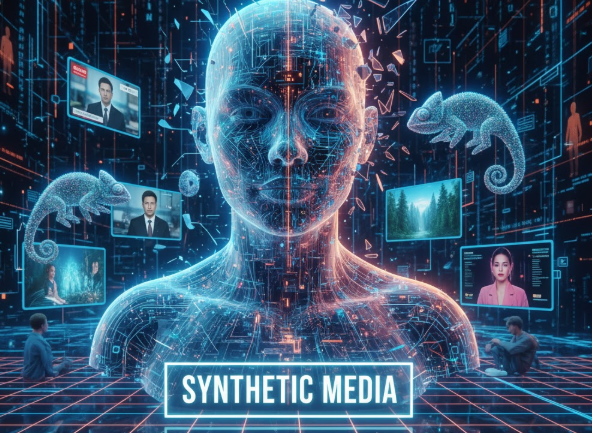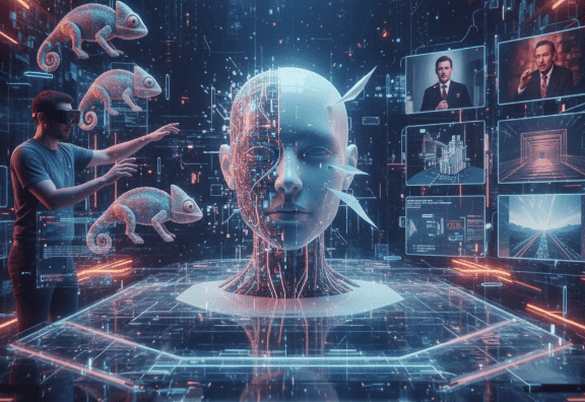In recent years, synthetic media has emerged as a dominant force in digital content creation. From AI-generated images and deepfake videos to realistic voiceovers and virtual influencers, it is transforming how brands, media companies, and individuals create and consume content. The U.S. leads this shift, driven by rising digital engagement, rapid tech advancements, and a growing demand for new forms of storytelling. By 2025, it is set to become the largest market for synthetic media adoption.
This paper will further unfold the subject of what synthetic media is, how it works, the sectors benefiting from synthetic media, pros, cons, and reasons why the tech is of increasing prominence in the USA.
What’s Synthetic Media?
Synthetic media denotes content produced or modified artificially with the assistance of artificial intelligence, machine learning, or automated technologies. Synthetic media makes the best use of AI to produce what humans do in crafting audio, images, videos, and text.
On a similar note, deepfake techniques can generate super-realistic simulation videos. AI-generating-music technologies and voice-over artists can craft a human voice with an astoundingly accurate imitation of human speech. This eradicates the need for human creativity to produce content of rather impeccable quality, all at a lower price.
Moreover, on top of that, this kind of innovation allows a level of invention that traditional methods simply could not achieve.
How Synthetic Media Works
In essence, synthetic media relies on advanced AI algorithms, mainly GANs and NLP. Here’s a simplified framework of how it works:
- Data Input – The AI models are justified to be fed such mammoth datasets, including images, video captures, and audio samples.
- Pattern Recognition – The algorithms analyze the data to learn how humans speak, move, and create content.
- Content Generation – Equipped with this knowledge, the AI produces synthetic media that mimics real-world media.
- Refinement and Realism – AI refinements boost realism, fix errors, and improve overall coherence.
Furthermore, ongoing AI improvements continue to make synthetic media increasingly realistic, and as a result, harder to distinguish from real content.

Applications of Synthetic Media in the USA
Overall, synthetic media is gaining huge approval across numerous sectors in the USA. Moreover, it is widely applied in entertainment, marketing, education, healthcare, and more.
Entertainment and Media
Moreover, Hollywood and streaming platforms are actively embracing synthetic media, using AI-generated actors, avatars, and deepfakes to cut costs, speed up production, and enhance storytelling.
This means that a certain star can feature in a role across several films without aging or dying. In the end, viewers get more immersive storytelling experiences in no less imaginable adventures.
Marketing and Advertising
Brands in the USA are playing more and more with synthetic media on the marketing front. AI-generated videos, virtual influencers, and synthetic voices are the tools brands are now using to engage their audiences more effectively.
Additionally, synthetic voices can translate ads into multiple languages and create self-sustaining virtual influencers, thereby allowing high-quality content to scale efficiently.
Education and Training
Students and trainees experience an omnipresent impact as synthetic media transforms classrooms and corporate training. AI-generated simulations, virtual teachers, and interactive content actively engage learners and personalize their experiences.
Educators can use synthetic media to create scenarios that are impossible, costly, or unsafe to recreate in real life. For example, medical students can practice surgeries through realistic AI simulations, giving them hands-on experience with far fewer risks.
Gaming and Virtual Reality
Furthermore, beyond simple hologram gaming, synthetic media creates lifelike characters, dynamic environments, and AI-driven dialogue, ultimately delivering immersive and interactive experiences
Using synthetic media simultaneously allows creators to produce content faster and cheaper, helping them stay ahead of the growing demand in the USA’s gaming industry.
News and Journalism
In newsrooms, synthetic media can automate reporting, create summaries, and even generate synthetic anchors. While this boosts efficiency, it also raises concerns about harming truth and accuracy.
However, many U.S. news organizations now use authentication tools to ensure synthetic content is ethical and based on verified sources.
Therefore, synthetic media is gradually changing the way Americans access their news while still protecting public trust.
Benefits of Syntheticmedia
Some of them being good are:
- Cost Efficiency – Developing AI-based content creation could be significantly cheaper as compared to traditional models.
- Speed and Scalability –Most of the time, synthetic media can be instant; moreover, changes can quickly follow across diverse platforms.
- Creativity and Innovation – AI ensures a canvas of experimental ideas and scenarios, but has also been unable to materialize until now.
- Accessibility – Anyone who has limited resources, enterprises, and teachers can now work towards very high-quality content.
- Personalization – Anything that uses synthetic media can modify user experiences, from targeted ads to tailored education materials.
Consequently, seeing the advancement of synthetic media in the USA is justified, taking into account these imperatives: economy, creativity, and user experience.
Challenges and Ethical Concerns
Despite being such a beneficial aspect, synthetic media warrants various challenges and ethical considerations:
- Misinformation and Deepfakes – The realistic proportions of synthetic media will make misleading its contents very easy.
- Intellectual property: AI-generated content may potentially infringe on copyrights or likeness rights.
- Bias and Representation – AI systems may inadvertently reinforce societal biases that exist within the training datasets.
- Privacy Concerns – Using synthetic replicas of real people may grand issues related to privacy.
Consequently, law enforcement entities, private tech companies, and content creators in the USA are focusing more on elements and safeguards for ensuring the ethical use of synthetic media.
The future of Syntheticmedia in the USA
- Given the two-faced facet of synthetic media, one adorned with promises and the other having transformative potential, the times ahead can be steeped hopefully with some of these future considerations:
- Hyperrealistic Content – Go ahead of the border for AI creating content that hardly distinguishes from reality, making an impact on entertainment, marketing, and education.
- Personalized Experiences – A future with exactly tailored, personalized media content that the consumers love, follow, and really need.
- In terms of collaborative creativity, AI technology and humans will be co-creating work, intertwining the human imaginative capacity with the efficiency of the AI.
- By developing no-stakes denunciation tools and by keeping a real-time track of the incoming misinformation, the stringent requirements are aimed at lessening the danger of falsehoods and misuse.
- Enriched Implementations in Various Sectors – Synthetic media indeed sees its employment in healthcare, finance, and education.
Naturally, synthetic media is set to bring transformative forces in shaping the American culture on creation, content consumption, and the related interactivities digitally.
Conclusion
Synthetic media merges AI with human creativity, opening vast opportunities for innovation, personalization, and efficiency beyond entertainment and marketing.
Those who induce synthetic media deeply understand they possess extraordinary power. It-critical for their theoretical mappings to integrate ethical, regulatory, and transparency mandates and entreaties-possesses great concern to benefit society and uphold the sanctity of trust and privacy in their everyday operation.
Synthetic media adoption in the USA is growing fast, fueled by tech advances and demand for immersive, high-quality content. Creators, marketers, educators, and tech enthusiasts benefit by mastering it to stay ahead digitally.
Not only is synthetic media a step in the process, but it can also be termed as the future of digital content in terms of how Americans are viewing and engaging with it.



